Keywords
|
| M-Learning, Problem Based Learning, ICT, Courseware, Android |
INTRODUCTION
|
| Problem-Based Learning is a learning-centred pedagogy and widely recognized as an effective learning methodology based on current theories of learning including constructivism, social constructivism, situated learning and improves meta-cognition knowledge of learners. The students are presented with complex, real-life situation problems that are well aligned with the course objectives. This enhances their problem-solving skills, communicative and collaborative skills, analytic thinking and expert-level thinking process. The key components of implementing problem-based learning approach is to selecting unit goals and objectives, developing the problem scenario, background Introduction and learning content relevant to the problem given, defining the activities based on what the learner knows already and what the learner has to learn new, how he/she will learn and at the end of the process what he/she has learnt. Apart from this as based on communicative and collaborative process the learner has to be facilitated to find and share with his/her fellow learners using group discussion, developing proposed solution and to finally present the problem solutions that he/she attained. The role of the instructor is to facilitate the understanding of the problem through diagnosing needs, mentoring the learning, encouraging the learning process and to enable the selfquestioning practices. In addition to this the instructor role is to manage the learning process through managing work groups, monitoring the engagement, modelling inquiry, providing instruction and assessing the process. |
MOBILE LEARNING
|
| Technology plays a vital role in modernising global education systems worldwide. Mobile devices like Mobile Phones, PDAs and Tablet PCs are emerging as a powerful pedagogical innovation in the area of teaching and learning process. These devices helps to deliver the multimedia based educational content and also facilitates the interaction among instructors and learners for knowledge sharing and gives a true collaborative experience. The recent advancements in mobile technology and the mobile applications provides unique opportunities for both learners and educators by providing flexibility in terms of time and space without boundaries. Mobile Technology advancements helps in promoting the paradigm shift from teacher-centric to learner-centric learning process. The role of multimedia in education gives a major boost to this principles by integrating data, audio, video and other shared resources and creates a synergy among these learning objects. The existing learning tools are mostly adopted based on one-to-many approach and mostly faculty driven and is unsuitable in today's learning context. The instructor need to ensure active participation of the students in various collaborative activities like discussions, group activities by using tools like blogs, wikis and social bookmarking. The students and teacher can share wide range of file formats like documents, audio or video clips and pictures etc and to enable the content creation by both the learner and the instructor. With the proliferation and adoption of Mobile Technologies it is important to integrate the problem-based learning approach on Mobile learning environment. It is in this context Learning through Mobile devices has led to a powerful paradigm shift in the dissemination and deliverance of education and pedagogical content, course material, and literature. |
Design principles for mobile learning [4]
|
| Design principles are best expressed in active terms that enable their ready use by teachers and designers presented with similar contexts and problems. Herrington A.,et.al (2009) proposed the following characteristics for the incorporation of mobile learning into a higher education learning environment: |
| 1. Real world relevance: Use mobile learning in authentic contexts |
| 2. Mobile contexts: Use mobile learning in contexts where learners are mobile |
| 3. Explore: Provide time for exploration of mobile technologies |
| 4. Blended: Blend mobile and non mobile technologies |
| 5. Whenever: Use mobile learning spontaneously |
| 6. Wherever: Use mobile learning in non traditional learning spaces |
| 7. Whomsoever: Use mobile learning both individually and collaboratively |
| 8. Affordances: Exploit the affordances of mobile technologies |
| 9. Personalise: Employ the learners’ own mobile devices |
| 10. Mediation: Use mobile learning to mediate knowledge construction. |
| 11. Produse: Use mobile learning to produce and consume knowledge. |
| The following chapter discusses the M-learning framework developed based on the designing principles proposed above. |
M-LEARNING FRAMEWORK OVERVIEW
|
| The proposed idea of designing a mobile courseware using problem-based learning is implemented under broader scenario of m-learning framework developed by the author. This chapter discusses the methodology of implementing various prototype m-learning applications for evaluating the usability of the framework in various educational setting based on learning theories. The real-time implementation in higher education environment like colleges and universities is considered. the framework developed is based on pedagogical, technological and usability perspectives which is discussed below. The proposed m-learning framework consists of four components: |
| 1) Mobile Devices (User Infrastructure) |
| 2) Mobile Applications (Installed in the Mobile Device) |
| 3) Mobile Middleware |
| 4) Wireless Network Infrastructure (4G/3G / Wi-Fi) |
| 5) Back End System (Hosting LMS Application and Services) |
| The framework is based on Service Oriented Approach using Web Services as its underlying implementation scenario. This framework is focusing on providing ubiquitous learning environment to the end user. The framework is built upon pedagogical, technological and social aspects. The framework is depicted in figure 1. |
| A.User Infrastructure |
| The framework supports PC, Laptop and Mobile Devices. Owing to the proliferation of mobile devices, Smart Phones and Tablet PCs are considered as part of prototyping, developing and implementing the Mobile Applications. |
| B.Mobile Applications |
| The mobile application installed on the mobile device presents a unique user interface for the learner to invoke and consume the various services associated with the mobile learning scenario. The prototype application is developed for Android platform considering its open architecture. The application will be developed and deployed for other proprietary and non-proprietary platforms like iOS, Blackberry and Windows Phone after the evaluation of the framework. The application developed is to work on on-line and off-line mode and synchronized with the back-end server whenever the device connects with the backend system through Wireless Network Infrastructure like Wi-Fi or through Mobile Network like 3G/4G. The application is built upon modular structure and each module works coherently with other modules. The application is to support wide variety of data like Images, audio(podcasting)/video, documents, Portable document files and other file formats. |
| C.Mobile Middleware |
| The mobile middleware is the heart of the M-learning framework that is being developed as part of this research work. It operates on component model, interoperable with both the back end legacy LMS, database server and also with PC, Laptop, Tablet PC and other Mobile devices. The middleware is built with PHP and REST API for providing web services. It accepts the request from the mobile client and translates this request as a web service to fetch the appropriate content from the backend servers through Internet connections. The raw data collected from the back end servers are formatted according to the requested mobile device profile and the formatted content is sent back to the mobile devices in a presentable manner to the invoking mobile applications. It gives a ubiquitous learning environment for the learner. |
| D.Network Infrastructure |
| The wired and wireless network infrastructure is used to connect the back end server through the middleware by the Mobile and other user devices. Typically the user may use the wired network available at home or at the classroom laboratory sessions to connect from the PC and Laptop. The wireless connection is mostly used by Mobile devices. In a home network or in campus environment the student may invoke request from their mobile devices through the secured Wi-Fi connection. While the user is commuting, or being present at various places other than home or class room environment, the user connects through mobile networks with varying network configuration and speed like 3G/4G. |
| E.Backend System |
| The typical backend systems employed in our scenario is Learning Management System and this back end systems may be integrate with other servers like mail server, LDAP authentication server, social networking, video server or any other server which provides the requested data to the mobile clients through the mobile middleware as a service. |
MOBILE COURSEWARE
|
| The courseware designed for traditional classroom environment and for the mobile learning differs in various learning contexts. The discussion involved in our case is to design a mobile courseware for ICT students using PBL approach. The mobile learning environment supports wide variety of learning content and accordingly the learning objects are being deployed onto the server for easy access by the learner. |
| The instructional principles [6] that can guide the practice of teaching and the design in problem based learning environments are : |
| 1. Anchor all learning activities to a larger task or problem. |
| 2. Support the learner in developing ownership for the overall problem or task. |
| 3. Design an authentic task. |
| 4. Design the task and the learning environment to reflect the complexity of the environment they should be able to function in at the end of learning. |
| 5. Give the learner ownership of the process used to develop a solution. |
| 6. Design the learning environment to support and challenge the learner's thinking. |
| 7. Encourage testing ideas against alternative views and alternative contexts. |
| 8. Provide opportunity for and support reflection on both the content learned and the learning process. |
| In the next section we will explore how these eight instructional principles are realized in the problem-based learning approach in our case study for ICT students. In the problem-based learning environments the computer application (ICT) students are divided into groups of six and each group of student with a facilitator. The students are first provided with the learning content as in our case is Java Programming. The ultimate goal of this course is that the students has to assimilate the individual parts or compartmentalized ideas that he/she presented to write or solve a Java Program for a specific problem. We may assume that the student has been asked to write a program to calculate the roots of a Quadratic Equation. The student has been taught with Object oriented programming principles, fundamental programming structures of Java, Objects, Classes, Interface and Methods syntax, various Java packages etc. |
| The student is then provided with Multimedia learning objects to augment his/her learning process. The student practice and self-assess their learning progress by attempting quizzes, tests and practice with flash cards. Then the student finally attempts the problem that they were asked to solve. |
| The student makes an attempt to solve the problem individually and then discusses their ideas and approach with the fellow learners in their group for achieving the best possible result. The student cannot assume the solution until they were presented with the given problem. The student is supported with a view that the underlying problem here is to find the roots of a quadratic equation. Thus the student is clearly presented with the task. The learner takes the ownerships in this case by assuming the problem and building task based on their own views. The student is now challenged and realized with the complexity of the problem to be solved and the learning that they acquired should be applied with cognitive skills. The teacher's role here is to challenge the learner's thinking -- not to dictate or attempt to systemize that thinking. Learners use learning resources (all media types) and instructional materials - learning objects (LOs) as sources of information. These materials do not teach them, but rather support the learners inquiry or performance. The students have to work in group to solve the problem together which enables collaborative learning experience. The evaluation and feedback is provided for the students for their learning outcomes and they were asked to put forth their problem-solving approach through a presentation. This helps them peer-learning process. The mobile application developed for this approach is discussed in the next section. |
SYSTEM IMPLEMENTATION
|
| A student belonging to computer science goes home at the end of a classroom session. The user logs into his/her m-learning app. The lessons are posted for various computer science courses. The user browses the Course List and under this the user chooses "Java Programming" for this semester. The user finds a list of lessons under the "Java Programming" and navigates to the lesson "Object Oriented Programming Introduction" which the user was taught in the classroom session. The user browse through the lesson and spends some time with it. The user underlines (presses) the important points he/she pondered within his/her Note Taking Feature of the App. This Note Taking Feature helps to copy the words or sentences that he/she chooses to his clipboard. The lesson content is so designed and allows interactivity by clarifying the technical jargons he/she chooses and wish to refer the meaning of it and popping out for him/her to keep it notes arena. The request has been sent to the server and downloads the associated media file into the media arena. During the downloading of file he/she browses the remaining lesson content. |
| The user further wants to have a deeper understanding of the concept Inheritance. The user submits his/her request to the server and it lists him/her some of the resources available through searching on the web and enables him/her to download the podcast and video. After some time the user Navigates to the Quiz Menu and answer the MCQs and submit the result to the back end server for evaluation. |
| Having evaluated by the server it pops a message through Push notification that his/her results for the quiz is available. The Push notification also updates the that the particular student has taken the exam and his/her grades available for the instructor analysis. |
| The user then finds which of his/her friends who have completed the lesson and answered the quiz. Those who completes the quiz joins the discussion forum and discusses on various topics of the lesson. Later they were asked to answer for a poll question. The user submits some of his/her doubts to his/her Instructor and to the fellow learners for clarification. |
| Another important contribution of the research work is that the user can share the content to the other user outside the classroom environment or to other groups which are not a restricted one by the instructor. The user initially download the content to their mobile devices and since the devices have a limited memory the user can upload the content to the storage services like Drop Box from where the user can access the content in their laptop or from any other devices and can easily share with other user. It is a rewarding collaborative experience from the user point of view. |
Teacher View
|
| The teacher has been posted with the results and feedback from the students and their performance has been illustrated with graphical representation - which are the questions have been answered by all the students and which of the question student felt it tough etc. The teacher keeps note of all this and thinks of altering the lesson plan accordingly to fit into the next classroom sessions. |
| The teacher share the results with other teacher, course administrator and concerned authorities for learn analytics and to seek idea for improvising the student further. |
| The dashboard and Problem-Based mobile learning application screen shots, designed for Java Programming course, is illustrated in the figure 3 to figure 9 with the wire framing concepts. |
| The dashboard consists of various menus related to mobile learning applications like courses, notifications, calendar for entering and viewing the academic and activity schedules, the media menu to browse, download and store the various media files like podcasts, video, animation and images associated with the course and lessons, the discussion menu for joining and discussing the various topics in the discussion forum. |
| The assignment menu to view the various assignments posted by the instructor relevant to the lessons, the flash cards are provided to have a quick view or bit-sized information relevant to the lessons studied, the messaging menu for interacting with the fellow learner and instructor and the notification menu helps to browse the learning activities, status of the downloaded files, the new messages posted by the fellow learners, the learners who are available on-line, posting of a new lesson content an audio, document or a video file either by the fellow learner or by the instructor. |
| The dashboard which is displayed in a grid view with images enables the learner and instructor to have a bird's eye of the complete features available in the mobile learning application and also enables quick and easy navigational features. |
| The dashboard also helps to synchronize the application with the back-end server and also to give the updated view of the application to the learner. It also sync with the back-end server the usage data and other log files of the application to provide the personalized learning environment. |
| The mobile learning applications is built on sound pedagogical principle to support the learners from diverse background. This application itself serves a template for implementing various prototypes based on learning theories and on different learning context. The figures from 3 to 9 given in the following pages gives the overview of the mobile courseware designed for "Java Programming" course as a case study for the implementation based on Problem-based approach. |
| The Problem-based learning (PBL) screen shot depicted in the figure 7 lists various option for the mobile courseware designed with PBL approach. The learner is initially presented with the learning content which involves various learning objects based on the course. The student acquires the background information required to solve the problems using PBL. It fulfills the first principle of PBL approach what the learner needs to know. Having acquired the basic content knowledge, the student augments his/her learning with the learning objects listed under the Multimedia menu. It contains various podcasts, video files and other relevant images associated with the problem given as a supporting documents. |
| The student then clicks the Flashcard menu to review his/her learning and contrive his/her knowledge mapping with the various glossaries, terms, definitions and key concepts. The student can also participate in the group discussion with the help of the Group Discussion menu option. When the user clicks this option the menu lists the various users who are connected with this discussion and their threads to follow. Each user has posted different viewpoints based on their individual learning skills and approach. The user presents with a Quiz option to test his/her learning progress relevant to the content arena. |
| The learner may then click the Problem-Solving menu where he/she was presented with a list of problems to be solved. The complexity nature of the each question tests the users understanding related to Java programming language syntax (as in our case study), coding practices, fundamental programming structures and their usage, function - their declaration, usage and execution, Java packages - their functional specifications, relevancy, the methods, Objects and Classes - the depth in understanding of object oriented programming principle and the other skills in identifying or improving the problem. Finally the user is provided with a Presentation menu option to present his/her learning skills by providing an alternative solution or the enhancement required to solve the problem with his/her supporting views. This presentation is stored and can be exchanged with both his/her fellow learner and to the instructor for evaluation. This presentation enables the instructor to assess each individual learner in terms of his/her understanding of the problem, skills he/she acquired, the problem-solving approach, the new knowledge that the student has acquired, his/her communication skills and the skill to solve it through group learning etc. The presentation enables the fellow learner to acquire the different views and approaches based on their unique experience and enable him/her to improve through peer-to-peer learning . |
RESULTS AND DISCUSSION
|
| A questionnaire with a 5-point Likert scale was provided to the Master of Computer Application students belonging to a city college, who were provided with mobile devices installed with the m-learning application, to evaluate the mobile learning experience built on Problem-based learning approach. The class consists of 60 students and the students have actively participated in using the m-learning application and also provided the response with their feedback based on the questionnaire given. The results are not tabulated here. But based on the overall feedback obtained and the synthesis of the findings revealed that the mobile courseware designed for ICT students by using problem-based learning approach in the mobile learning environment enhances the overall learning experience through mobile devices. The problem-based learning approach adopted in mobile learning environment helps in achieving integrated approach while designing the course, enhances the problem-solving skills, enhances the object oriented programming principles while writing programs to create objects and functions during coding, it gives unique approach for solving the same program differently by individuals, enhances the communication, group discussion and collaborative learning skills. |
| The objectives for attaining effective learning can be realized only when the learner does the active role which has been envisaged and opined by the constructivist theory. This mobile learning application was built on this approach. It takes the understanding of the learner beyond the original content or idea given in the problem to developing their knowledge to construct new learning and problem-solving approaches either to shorten the execution time of the program that they develop or to minimize the iteration or to minimize the lines of programming code as in the case of ICT students. This approach enables the instructor to create an interactive teaching experience for the motivated students and to build peer-to-peer learning models. |
CONCLUSION
|
| Our goal in this paper is to present the feasibility of designing a mobile learning courseware based on PBL approach and implementing this on the novel mobile learning framework developed based on Service-oriented architecture. The case study presented in this article for developing a courseware for Java Programming for ICT students encourages the use of various learning pedagogies like problem based learning and other instructional design strategies on the Mlearning framework used in this project. This approach envisages and enables learner-centric approach in the mobile learning platform and the M-learning framework supports accordingly. This framework is built on the ubiquity principle and supplements both the traditional learning environment like classroom-setting and during the mobility of the students in-campus and off-campus environment. The evaluation of the designed framework was tested with the group of students belonging to Master of Computer Applications (MCA) program. The M-learning framework is developed to support open platform like Android. This applications can be implemented in other Mobile Platforms like iOS, Blackberry and Windows Mobile. |
| |
Figures at a glance
|
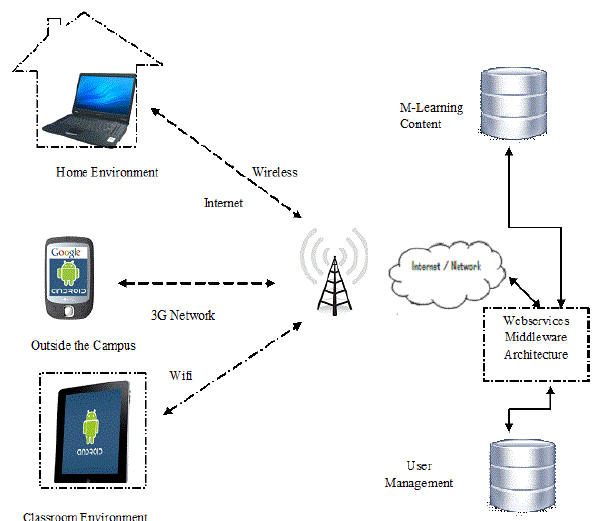 |
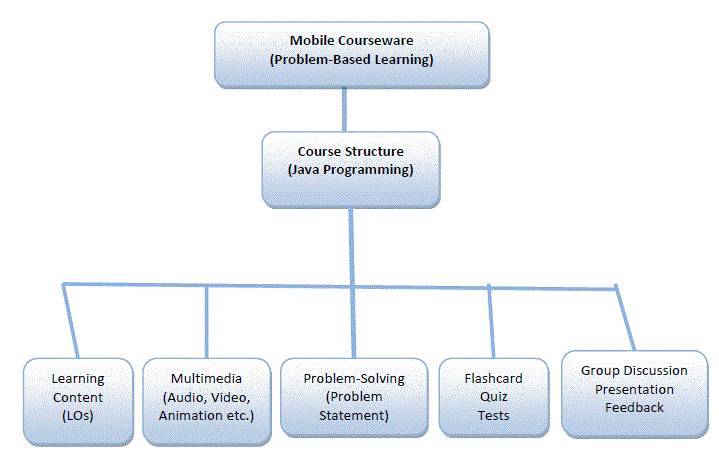 |
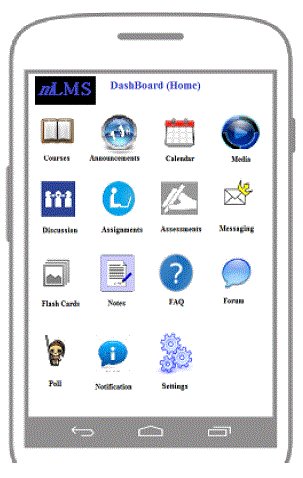 |
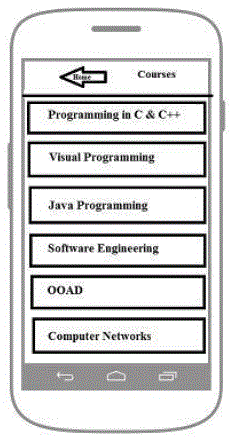 |
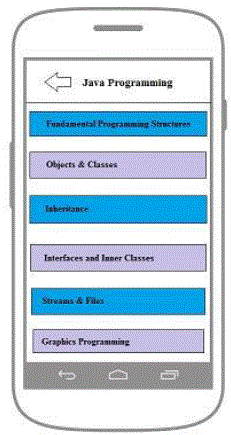 |
| Figure 1 |
Figure 2 |
Figure 3 |
Figure 4 |
Figure 5 |
|
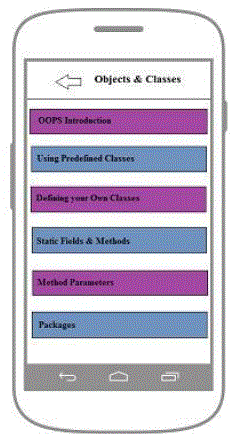 |
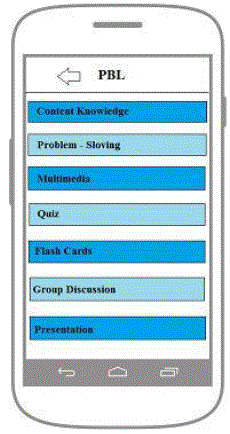 |
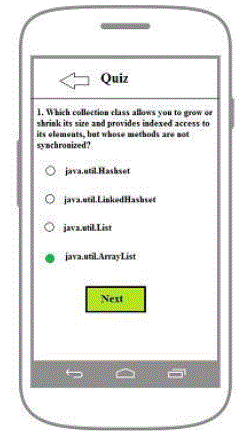 |
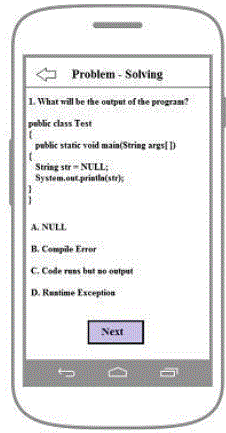 |
| Figure 6 |
Figure 7 |
Figure 8 |
Figure 9 |
|
| |
References
|
- Attewell, J. (2008)., "Towards sustainable large scale implementation of mobile learning": The mobile learning network (MoLeNET). In JTraxler, B. Riordan & C. Dennett (Eds.) The Bridge from text to context. Proceedings of the MLearn 2008 Conference, pp. 28-35.
- Chang C.Y., Chan T.W.., Sheu J.P. (2005)., "., ?Concept and Design of Ad Hoc and Mobile Classrooms,? Journal of Computer AssistedLearning, Vol. 19, pp. 336
- Esko.N, Seppo.T and Lauri.M (2005), " PBL and Computer Programming — The Seven Steps Method with Adaptations", ComputerScience EducationVol. 15, No. 2, June 2005, pp. 123 – 142
- Herrington, A, Herrington, J and Mantei, J, (2009), "Design principles for mobile learning, in New technologies, new pedagogies: Mobilelearning in higher education, Faculty of Education, University of Wollongong, pp 138-145.
- Hoffman B., Ritchie D. (1997)., "., ?Using multimedia to overcome the problems with problem based learning,? Instructional Sciencepp.97–115
- John R., Thomas M., (1995)., "Problem Based Learning : An instructional model and its constructivist framework"., EducationalTechnology, Vol.35, pp31-38
- Motiwalla, L. F.(2007), ?Mobile Learning: A Framework and Evaluation,? Computers & Education, Vol. 49, pp.581-596.
- Naismith L., Sharples, M., et.al. (2005)., "Literature review on Mobile Technologies and mobile learning", FutureLab Series.
- Shanmugapriya, M., Tamilarasia, A. (2011). Designing an m-learning application for a ubiquitous learning environment in the androidbased mobile devices using web services, Indian Journal of Computer Science and Engineering, Vol. 2(1),pp 22-30.
- Sharma, S. K., & Kitchens, F. L. (2005)., "Web services architecture for m-learning. Journal of e-Learning," Vol. 2(1), pp. 203–216.
- Sharples, M., Taylor, J. and Vavoula, G.(2005), ?Towards a Theory of Mobile Learning,? Proceedings of MLearn 2005 Conference.
- Traxler, J. (2007). Defining, discussing, and evaluating mobile learning: The moving finger writes and having writ... International Reviewof Research in Open and Distance Learning, 8(2), 1-12.
|